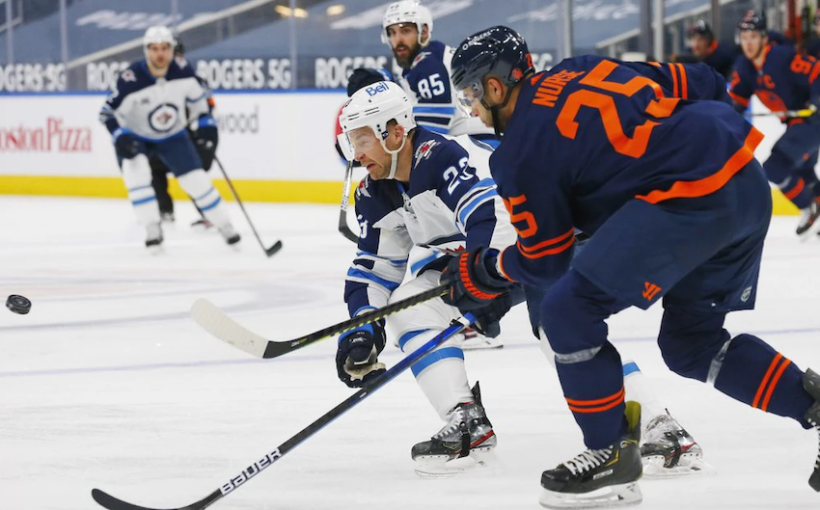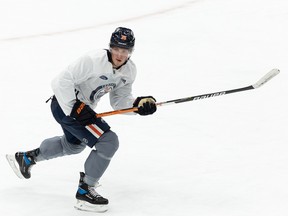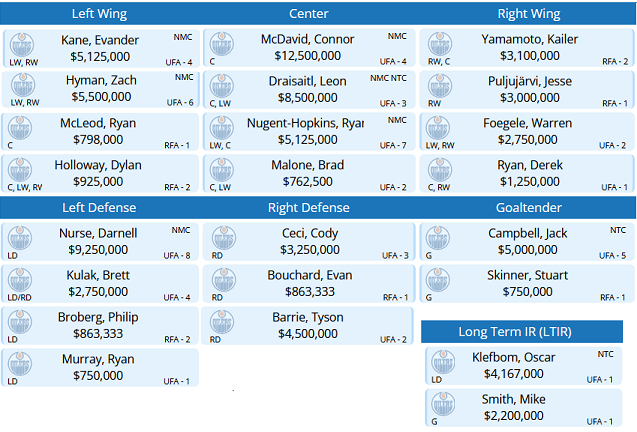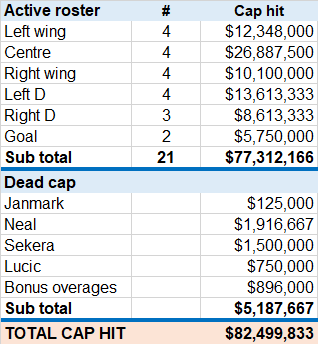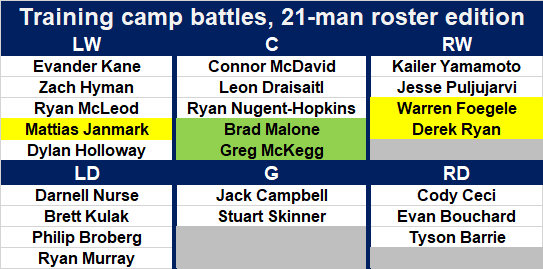With training camp now underway and the countdown on for the regular season, the Edmonton Oilers find themselves in salary cap hell.
- Darnell Nurse was signed to an 8-year extension at $9.25 million per season in the summer of 2021. That will take effect this fall.
Increase: +$3,650,000.
- Evander Kane‘s cap hit was a shade over $2.1 million last season, but got bumped to $5.125 million for each of the 4 years under his new deal.
Increase: +$3,016,304.
- Kailer Yamamoto signed a new 2-year deal at $3.1 million, a tidy raise from last year’s $1.175 million.
Increase: +$1,925,000.
- Jesse Puljujarvi signed a 1-year extension that saw his cap hit surge from $1.175 million to $3.0 million.
Increase: +$1,825,000.
- Brett Kulak‘s raise on his 4-year extension was a more modest one from $1.85 to $2.75 million, though from an Oilers perspective he had 50% of his old pact retained by Montreal last season, where as now the local club is paying full fare.
Increase: +$1,825,000.
Obviously something had to give and it did, just not enough.
- Duncan Keith announced his retirement in early July with a year to run on his contract.
Decrease: -$5,538,462**. - Zack Kassian was traded with sweeteners to get the last 2 years of his contract off the books.
Decrease: -$3,200,000**.
- Kyle Turris’ contract expired, then he announced his retirement.
Decrease: -$1,650,000**.
- Kris Russell’s contract expired and was not renewed.
Decrease: -$1,250,000**.
Ditto for Keith whose projected replacement, Philip Broberg, comes in at $863,333 in salary/cap hit, plus bonuses that can be accounted for next season. The net savings is still pretty substantial at $4.675 million, but it’s not quite all of Keith’s salary.
Then there was the scramble surrounding the netminding position, which saw the expiry of Mikko Koskinen’s $4.5 million pact and the reclassification of Mike Smith‘s 2.2 million deal to Long Term Injured Reserve. They’ll be replaced by newcomer Jack Campbell at $5.0 million and youngster Stuart Skinner at $750,000. That’s a “net” savings of $950,000, which helps, but again not enough.
All summer long the expectation was that the Oilers would make one more trade to solve their cap issue, perhaps even opening sufficient space to bridge restricted free agent Ryan McLeod to a 2- or 3-year extension.
Problem was there was a very limited number of players whose departure could make a significant difference. Other than Keith, all the $5 million+ players were locked in, either as core franchise players (McDavid, Draisaitl, Nurse) or as recently signed long-term contracts (Zach Hyman, Ryan Nugent-Hopkins, Kane, Campbell) many of them laden with no movement clauses. Meanwhile, the many, many players at the bottom of the roster make close enough to league minimum that there’s not much to be had in the way of savings.
The trade talk therefore swirled around the 4 Oilers in the mid-range of $1.5 to $4.5 million, namely Tyson Barrie, Warren Foegele, Puljujarvi and Yamamoto. But guess what, other teams are tight to the cap too. As summer wound down, no trades had occurred.
That culminated on the morning of the autumnal equinox, which more to the point was the first day of on-ice sessions at Oilers training camp. That’s when restricted free agent Ryan McLeod came to terms on a one-year extension for the strangely specific cap hit of $798,000. Before the ink had dried on that new deal, McLeod was already on the ice with his teammates; he and Holland had literally waited until the last minute for a change in circumstances that wasn’t forthcoming.
But why $798,000 and not $800,000? At face value the discount seems like a gratuitous insult, but there was method to the madness.
The exact figure was in fact predicted a couple of days earlier by Hart Levine of PuckPedia.com. In an interview with Bob Stauffer on Oilers Now on Tuesday, Levine advanced a possible opening roster of 21 players that covered off some interesting wrinkles, most importantly that bonus babies Broberg and Dylan Holloway be included on that opening-day roster. If they are, only their salary counts against the cap; if not, at such point as they got called up during the season, both their salary and their maximum bonus would count against it. That’s $850k in the case of Broberg, $500k for Holloway. With the Oilers’ cap as tight as it is, that’s a potentially crippling tax that would be a major deterrent for recalling either player.
So Levine worked backward from there, projecting both to be on the roster. He assumed a pair of vacancies, effectively not replacing Kassian and Turris at all.
Many of the other selections are automatic, leaving a handful of players on the bubble and a couple more on the wrong side of the inch. Under the most feasible scenario, there was $798,000 and (small) change left for Holloway’s deal. And that’s exactly what he got.
That’s some pretty stellar detective work, Mr. Levine!
A couple of days later when the McLeod extension came in at the predicted amount, Levine followed up with this tweet:
So… 12 forwards, 7 defencemen, and 2 goalies. One of the veteran centres Brad Malone or Greg McKegg (both with identical cap hits of $762,500) on the squad, but one more expensive player sent out. Levine noted that either one of Mattias Janmark or Derek Ryan (both at $1.250 million) could be sent out, with a maximum of $1.125 million to be buried by such a move.
The scenario leaves no room at the inn for either Devin Shore or Dmitri Samorukov, both on inexpensive deals which are nonetheless $100,000 and $25,000 above the league minimum. There simply isn’t enough margin for figures as modest as that. It’s razor thin.
Using the Armchair-GM mode of CapFriendly.com, I produced this roster.
Lines and pairings from the early days of camp, though with a bit of mixing and matching on the fourth line.
This model projects Ryan and Malone on the team, Janmark and McKegg the odd men out, but there are other permutations with the same dollar figures.
Summing all that up, we get this breakdown by position:
Wowsa, that is cutting it close.
Big advantage to doing things that way is that with the Oilers destined to spend yet a third year dipping into Long Term Injury Reserve, it is to their advantage to push the opening cap hit as close as possible to the ceiling of $82.5 million. The LTIR rules state that whatever the cap hit is on Day 1 is effectively the team’s limit for every day thereafter. It’s constrictive as hell, but that’s the way it is. Might as well push it as close to the ceiling as possible
Oscar Klefbom has been the common denominator each year, as his burgeoning career came to an untimely end with 3 years to run on what had been a value deal. This year he is joined by Smith. The good news is that this is the last year of both pacts, meaning that barring a new long term injury this problem may go away next season.
The LTIR effect on cap is net zero so not shown on the second table.
This situation could still be resolved with a preseason trade, or heaven forbid, a significant injury to a player with a serious contract. Assuming neither, the above or a variation thereof seems likely to be in the cards.
Not sure how viable a 21-man roster is in the longer term. It doesn’t leave much room to replace players with short term injuries, as are certain to occur. In such scenarios the club is obliged to cover the contract of both the injured guy and his replacement. Only longer term injuries (minimum 10 games or 24 days) provide cap relief.
Let’s express it again highlighting all of the players on the bubble:
Under the PuckPedia scenario, all the players with white backgrounds, including Broberg and Holloway, are locks to make the opening roster. Broberg is expected to make the team under any scenario, Holloway not so much though this would get his foot in the door. (He could still be sent out later, as long as his replacement didn’t exceed his base salary of $925,000.)
23 men on this list, a normal NHL roster but not enough cap space to accommodate them. Of those with green backgrounds, one of Malone or McKegg would make it, the other would be odd man out under the PuckPedia scenario. On the wings, one of the guys with a yellow background would miss the cut. In addition to Ryan and Janmark, I have included Foegele here as an outside possibility. With his $2.75 million cap hit he would be the likeliest of the three to clear waivers; on the other hand if a team with cap space were to put in a claim on him, that would relieve a lot of pressure, as he potentially represents an additional $1.5 million in buried cap than do Ryan or Janmark. That obligation would disappear were he to be claimed.
It’s all speculation for now. In the meantime, expect a spirited preseason battle among the highlighted players in particular. It all gets underway Sunday afternoon when the Oilers host Winnipeg Jets.
Source: EdmontonJournal
